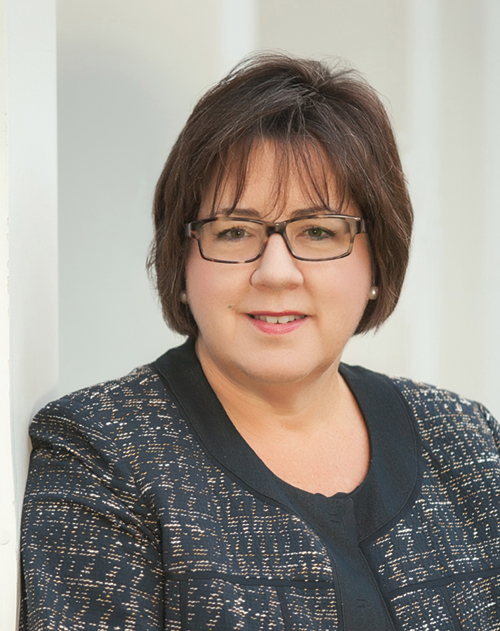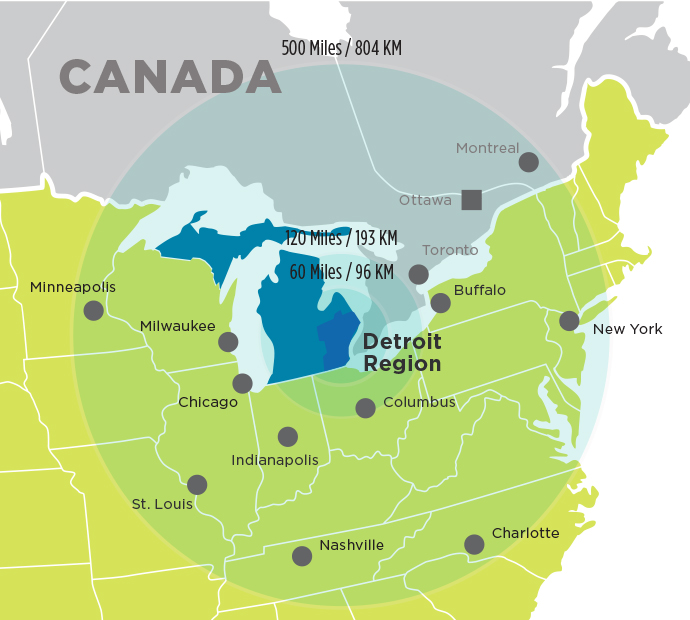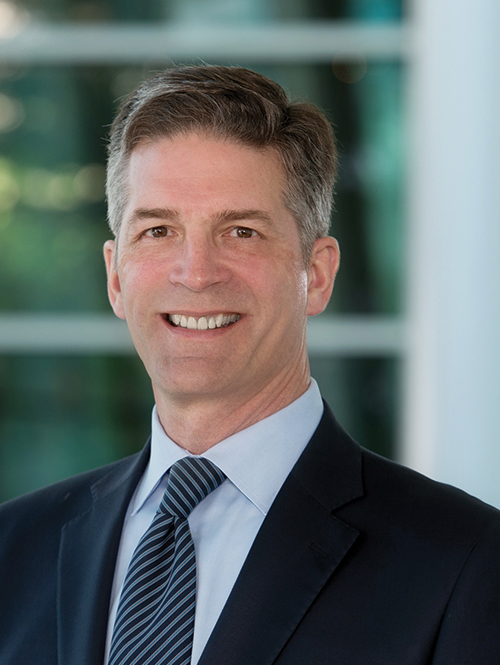The Detroit Region’s talent quotient in research, engineering and design is so strong it’s an industry cluster unto itself, alongside the others it feeds in such fields as mobility, smart manufacturing and financial services.
Look no further than Lordstown Motors. The Ohio-based company plans to establish an automotive R&D center in Farmington Hills as part of its long-term vision of establishing an electric vehicle epicenter in the Midwest.

“Lordstown Motors’ new R&D facility will drive new advancements in future mobility and demonstrates the strength of the talent in the state’s R&D and mobility sectors,” said Michigan Economic Development Corp. (MEDC) Chief Business Development Officer and Executive Vice President Josh Hundt when the project was announced in November 2020.
“Michigan alone accounts for 72% of all U.S. automotive R&D,” says Maureen Donohue Krauss, who recently took the helm as president and CEO of the emerging Detroit Regional Partnership, whose team put together a hiring resources playbook that helped Lordstown efficiently navigate institutions and associations to identify the talent needed to scale their operations quickly. “The Detroit Regional Partnership was proud to support the MEDC on this project,” Krauss says, “and provide Lordstown Motors with strategic connections to key local workforce and educational partners.”
Shedding light on the region’s talent resources, business dynamism and assets both hard and soft is one of the reasons why the DRP was formed in 2018, bringing together the best of programs found across the country to be a true one-stop shop for domestic and global business attraction in the 11-county Detroit Region. The idea is to connect the region’s brainpower to companies who, to use real estate terminology, can put it to its highest and best use. Regional utility DTE Energy, for example, today is finding a much deeper selection of technical talent than it used to. “Put together the region’s engineering, tech and design talent, and it’s this transferable skill set for a lot of industries,” says Gerry Anderson, executive chairman of DTE Energy, who also serves as the chair of the Detroit Regional Partnership.

In fact, talent will play a major role in a new industrial sites and buildings program the DRP will roll out early in 2021. Krauss says the familiar strengths in industrial design and automotive will be highlighted, but the deep data the DRP team has put together also shine a light on the region’s compelling sub-clusters, not to mention key overlays such as transit connectivity. “With an emphasis on data, we want to help companies make smart decisions for long-term success,” she says.
“The best regions have business leaders who are bullish on the region and want to be active in pulling in their peers who are thinking about relocating or expanding,” Gerry Anderson adds. “The DRP board is made up of the top regional leaders who really care about this community, and are willing to do their part to educate businesses and help them become part of the fabric here.”
That fabric is as strong as a composite dreamed up in one of the area’s R&D labs. And the talent pipeline is open and unencumbered. The DRP helped attract 2,000 new jobs to the region in 2020 and continues to work a strong portfolio. An equally robust human portfolio awaits those prospects: With 328,343 people between ages 15 and 19 and 721,487 people between ages 20 and 29, the Detroit Region’s young talent base outshines those same age cohorts in Austin, Seattle and San Francisco. In fact, inbound domestic migration statistics show that between 2014 and 2018, 6,000 people moved from Austin to metro Detroit, becoming part of an 11-county labor force of 2.7 million.
“The quality of the workforce available in the metro Detroit region was the decisive factor.”
Detroit also scores better than Atlanta, Austin, Boston, Chicago, Denver and Los Angeles on CBRE’s 2019 Tech Talent Scorecard. And CompTIA’s Cyberstates 2020 report ranks Michigan No. 8 in the nation in terms of net tech employment job gains in 2019 (+10,963). CompTIA projects that the Detroit area’s base of tech occupation employment will grow by 3.1% by 2026.
The plethora of higher education institutions within the Detroit Region’s reach is staggering, and begins with Michigan’s University Research Corridor (URC) — Michigan State University, the University of Michigan and Wayne State University. The URC continues to compete with the nation’s top university innovation clusters in talent, R&D and tech transfer. Compared to seven other peer clusters — including Silicon Valley, Massachusetts’ Route 128 and North Carolina’s Research Triangle — Michigan’s URC ranks No. 3 nationally on the Innovation Power Index, a composite measure of how well research universities perform on key research university metrics, prepared by East Lansing, Mich.-based Anderson Economic Group.
The best proof that robust talent is paying off? Talk to the talented leaders doing the hiring.
Rich in Connections, Inclusive in Purpose
Clearcover, an insurance technology company, is establishing a new customer operations hub in the city of Detroit, its first large-scale expansion outside of its Chicago headquarters. In an interview, Heidi Craun, head of customer experience for Clearcover, says Michigan won out over Wisconsin and Indiana in part because of its ready job market.
“We chose Detroit for its consumer-serving talent pool, its diversity and its alignment with the company’s core values,” she says. “The result of this decision is that we are partnering with the city of Detroit to create up to 300 high-wage jobs over the next few years. Talent was a key factor for us. We needed people who have great direct-to-consumer skills and are actually available to work. Detroit hit both of those marks for us.”

That’s no accident. Just ask Bedrock’s first Chief Community Growth and Development Officer, Nadia Sesay, who stepped into the role in December.
“As we continue to build out our commercial real estate strategy, we always keep in mind that the environment we create with our portfolio is a powerful catalyst for talent retention and recruitment,” says Sesay, noting the importance of upward mobility and inclusion. “As Detroit continues to grow, so should the number of diversified employment opportunities.”
Workforce Quality a Decisive Factor
AKASOL, a Germany-based manufacturer of high-performance lithium-ion battery systems for commercial vehicles, announced in 2019 it would make a multimillion-dollar investment and create more than 200 jobs at a new U.S. production facility in the metro Detroit community of Hazel Park.
“A tender was issued to over 300 counties across the USA,” says Roy Schulde, President of AKASOL’s US subsidiary AKASOL INC. “The counties represented a comprehensive list of likely manufacturing locations for a Tier 1 automotive supplier.”
That list was whittled to 40, then 10, then four finalists that merited a repeat visit. Why did Michigan turn out the winner?
“Given that AKASOL was opening our first manufacturing facility in the USA in the e-mobility segment, the quality of workforce available in the metro Detroit Region was the decisive factor,” he says. “Manufacturing is in the DNA of the workforce in the metro Detroit area, so all necessary disciplines to support the ramp-up of a new production facility are covered.”
“We chose Detroit for its consumer-serving talent pool, its diversity and its alignment with the company’s values.”
The Detroit area has been on the frontier of mobility for over 100 years. That future-oriented infrastructure has paired with a high number of engineering graduates to give the Detroit metro a 2.95 Location Quotient for engineers (1.0 is the U.S. average), ranking the region No. 1 in the U.S. in engineers per capita. As of 2019, there were nearly 103,000 engineers employed in the 11-county Detroit Region.
Asked about success recruiting people to Detroit, Schulde says it wasn’t necessary: “We found that access to all of the necessary domestic talent needed to start our operations were already located in the region.”
The company is already expanding its plans for the site, initially slated for a capacity of 400 megawatt-hours (MWh). Beginning in late 2021, AKASOL will commission its Gigafactory 2 in Hazel Park with gradual expansion to an annual total capacity of around 2 gigawatt-hours (GWh) planned by 2023.
Not Your Father’s Call Center
FCR, a business process outsourcing (BPO) and contact center firm based in Oregon, was known until 2020 for selecting small rural towns in the Pacific Northwest for its operations. A reappraisal of its location strategy occurred in 2020, FCR CEO Matthew Achak tells me.
“Because of the pandemic, we had to move everyone home to protect their health and make sure we weren’t getting our sites compromised,” he says. That pivot combined with the nation’s racial issues provoke company leaders into thinking differently. “What do we stand for as a company? How can we access places with incredible potential? Detroit is a great example,” Achak says.
The company announced a new site in Romulus in September, followed by another site in Southfield in October, staffed initially by 20 to 30 people but with plans for hundreds more. As Achak said at the Romulus announcement, because of work-from-home, “We decided that instead of waiting for the demographics to change within our existing communities, we would proactively expand into diverse communities and communities of color. There are economic and demographic conditions in those communities that mirror what we see in Oregon, Montana and Idaho.”
Broadening from small bucolic towns to reinvigorating under-appreciated towns of all types could bring a new level of growth opportunities. “Southfield and Romulus were testing scenarios, and huge successes,” Achak says. “We’re looking at other towns in Michigan, and looking at expanding this into a number of states, into towns that are very untapped.”
As for talent, “there is definitely highly skilled labor in Detroit,” Achak says. “We haven’t even figured out how to unlock everything. Next year will be the exciting year. Expansion is just a natural progression.”
New Era, New Opportunities for Talent
Detroit Regional Partnership Chair Gerry Anderson has seen and heard enough to know what real economic momentum feels like.
“One thing I’ve heard repeatedly from people who visit Southeast Michigan and the Detroit Region is that this is a very authentic resurgence,” he says. Even his own board didn’t completely see it until they started having their meetings in revitalized city neighborhoods and felt the reality of renewal up close and personal, driven in part by an inflow of young people after the Great Recession.
“I remember saying to other business leaders, my wife and friends, ‘Something’s changed. The energy is different, and people are here now who are determined to put this region back on its feet and make it a really attractive place.’ It’s happened. It doesn’t feel as if it’s a top-down paste-over of big initiatives. It feels more like a bottom-up feed of people who really care about the region.”

Anderson says the remote work trend only plays into the region’s business case. He sees how it opens up choices for young people like his three sons.
“You see the struggle in other regions to put together a balanced and affordable lifestyle. You see talent leaving places where that’s unattainable and seeking out places where they can enjoy their lives and not break their backs paying bills.” He sees companies ready to pursue a hybrid model that includes remote work but also involves creating teams or pods of talent who live and work and train together in a community. “Southeast Michigan has a lot of dimensions that fit that description,” he says.
Anderson compares it to the feeling in Chicago in the early ’90s: a city on the move, with a lot of energy in its neighborhoods. That’s the Detroit Region today.
“It’s a nice life and an affordable life in comparison to a lot of places,” he says. “People can get their feet on the ground in a place that is up and coming, with a new, cool feel. Detroit has a lot of energy in these places. We’re pulling people in who want to be part of that.”
Smart companies of the future are taking note.
This Investment Profile was produced under the auspices of the Detroit Regional Partnership, a regional economic development nonprofit serving Southeast Michigan’s 11-county region that is home to more than 5.4 million residents, 2.7 million workers, 348 communities and 300,000 companies. For more information, visit www.detroitregionalpartnership.com.

